
Research Summary: Physical Wellbeing in Adults Born with a Cleft
Our Adult Services Manager, Kenny Ardouin, appeared in a live Q&A on Monday 10th August at 8pm to unpack the findings that are summarised here in more detail.
This included the all important question of “so, what next?” as we look to use what we we have found to improve the services and support that both we, and the NHS offer. In case you missed it, you can catch up by clicking on the button below or by scrolling to the bottom of this page.
Watch the Q & A on Facebook
Background
As part of the Adults Services Programme, 2018 saw CLAPA launch the ‘Whole of Life’ Survey, a comprehensive questionnaire for adults in the UK born with a cleft.
We know that cleft lip and/or palate impacts on people’s health, but we also recognise that cleft is not the only health condition that may be a concern for someone. We were interested to see if there were any patterns of other health conditions that tended to affect people with cleft more often than they affected the general population. So, we took a closer look at the physical health of adults who were born with a cleft.
The ‘Whole of Life’ survey included a couple of sections which asked about people’s health. The results of this part of the survey fed into an academic paper published in the Cleft Palate Craniofacial Journal (CPCJ).
This paper was authored by Kenny Ardouin, Adult Services Manager at CLAPA, Dr Nicola Stock, Centre for Appearance Research, and Sinead Davis, ENT Surgeon, Welsh Cleft Service.
We’ve summarised the findings of this paper below.
We’ll be discussing the findings of this paper and what they mean for the cleft community in more detail on Monday at 8pm. Follow us on Facebook, Twitter or Instagram to find out more and join the discussion.
Co-occurring health conditions
To better understand where cleft sat relative to people’s overall health, we asked people if they’d ever received a diagnosis of the UK’s most common health conditions.
We found that people completing our survey had a similar likelihood of having heart disease, diabetes, dyslexia, language impairment, autism and cancer as the general population. However, we found that people completing our survey were three to five times more likely to have asthma, three times more likely to have hearing difficulties and about a third more likely to have vision difficulties than the general population.
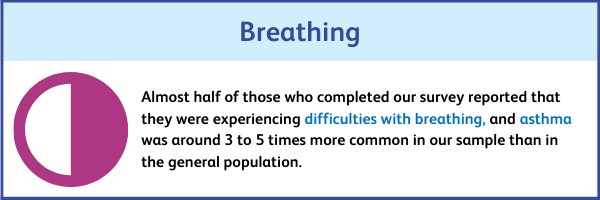
Breathing
48% of those who completed our survey reported that they were experiencing difficulties with breathing, and 54% of people reported that they snore. As a result, quite a few of these were sleeping in a different room to their partner because of their snoring. We also asked how many people breathe only through their mouth, vs their mouth and nose and found that 25% of people responding to our survey breathe only through their mouth. For other people, even though they may have been breathing through both their mouth and nose, they may only have had one nostril that wasn’t blocked, and the airway may have been very narrow which compromises breathing.
61% of people who completed our survey reported waking up with a dry mouth more than 3 days a week, while 17% woke up regularly with headaches and 16% with light-headedness – these all are indicators of sub-optimal breathing. 45% reported feeling excessively tired on a regular basis.
It is a concern that 70% of the people who completed our survey had never undergone a breathing assessment. Given how common breathing difficulties are, we’ve recommended that a breathing assessment forms part of routine cleft care in the future.
Join us next Monday 10th August at 8pm for our live Q & A, where we’ll be discussing the findings of this research in more detail, and looking at how can this paper be a useful tool for health practitioners to improve care for adults born with a cleft.
Watch the Q & A on Facebook
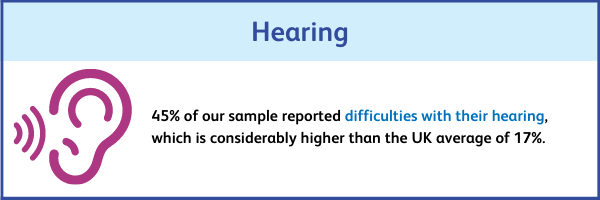
Hearing
45% of our sample reported difficulties with their hearing, which is considerably higher than the UK average of 17%. We know that hearing problems are more common in children who were born with a cleft, so it’s not entirely surprising that we would see that adults would also have a higher rate of hearing difficulties. It’s also worth pointing out here that of that 45%, only 48% of those people felt their hearing difficulties were cleft related, while 46% said they did not know.
We also know as you get older that hearing difficulties are more likely to occur as a result of age. 35% of our sample reported experiencing tinnitus (a ringing in the ears), this also is quite a bit higher than that of the general population. Interestingly, we compared our findings with a Norwegian cleft population, and still found our proportion of people reporting hearing difficulties in the UK was higher.
On Monday 10th August we’ll be hosting a live Q & A on our Facebook page to further unpack these findings.
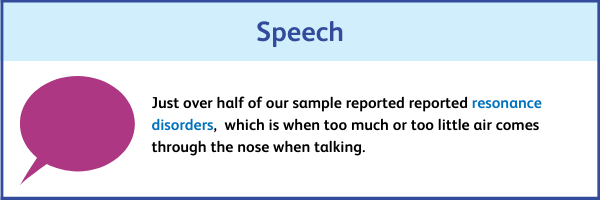
Speech
While 35% reported no speech concerns, 51% reported resonance disorders (which is either having too much air (hypernasality) or too little air (hyponasality) coming through the nose when talking), and 11% reported having a voice disorder. 71% reported that they had received speech therapy. Overall, participants were not particularly satisfied with the outcomes of the speech and language therapy they had received growing up. This may reflect the UK cleft service before modern centralised cleft teams that we have today, at a time when speech outcomes were shown to be particularly poor.
More encouragingly, on a scale of 1 to 5 where 5 indicates “people always/almost always understand what I am saying”, the average for this question was 4.42. Similarly, on a five point scale where 5 means “my speech sounds fairly typical for someone who speaks my language and dialect”, the weighted average was 3.86. The sound people reported to be most difficult is /s/ with 27% of participants finding this sound difficult.
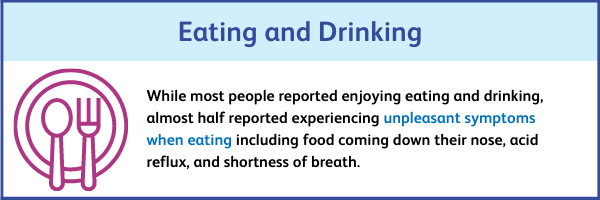
Eating and Drinking
We asked people about their experiences with feeding too. 8% of people completing the survey could not eat food orally at all, this is high compared to the general population. 27% reported avoiding certain foods because of their cleft. These typically included hard foods like crusty bread, spicy foods and small foods which may end up in a fistula, e.g. rice, nuts, seeds, popcorn, etc.
Almost half reported experiencing unpleasant symptoms when eating – the most common being food coming down their nose (nasal regurgitation), acid reflux, coughing/choking, and shortness of breath. Less common were nausea and pain when eating. That being said, the vast majority reported enjoying eating and drinking, enjoyed eating out in restaurants and feel comfortable to eat in front of other people.
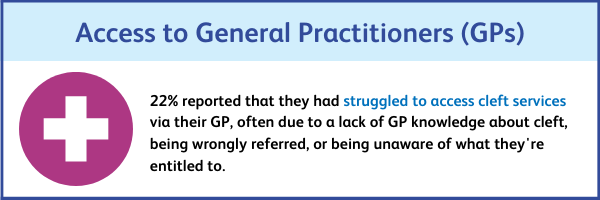
Access to General Practitioners (GPs)
Within the last 12 months before completing the survey, 77% of people had visited the GP, and 99% of people had visited within the last 5 years. Despite this high level of engagement with GP services, 22% reported that they had struggled to access cleft services via their GP. These difficulties included a lack of GP knowledge about cleft and its treatment, the patient themselves being unaware of what they’re entitled to, the GP or NHS trust being unwilling to put through a referral to the cleft team, or being wrongly referred to the wrong place or to private practice. 3 people had waited 3 years to get a referral, and one person had to have inappropriate treatment later corrected by the cleft team.
CLAPA’s Leaver’s Pack (currently on trial – request your copy here) seeks to address this by providing information both for patients and for GPs which explains how to process a referral to the cleft team.
You can also find more information about returning to treatment and common problems on our treatment pages.
Conclusions
People who were born with a cleft may be at risk of physical health issues in adulthood. Therefore, it’s recommended to monitor physical symptoms from an early age, and to have routine assessment of breathing, speech, hearing and eating and drinking in the Cleft Team during adulthood.
It is recommended that education for patients and GPs be improved to increase everyone’s understanding of the Cleft Services to prevent people receiving inappropriate or inadequate care.


